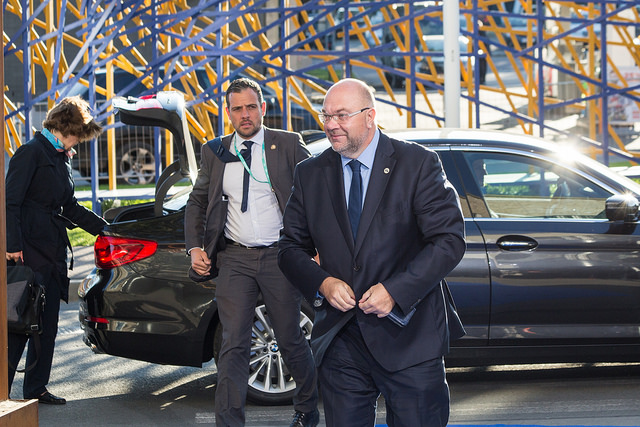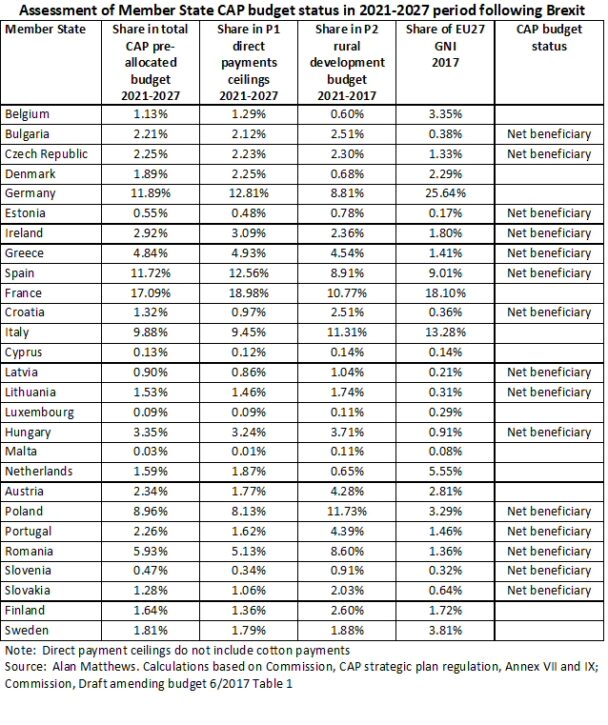The Commission’s CAP legislative proposals which were published on 1 June 2018 attracted some immediate reactions from different groups of stakeholders setting out their positions. The proposals are far-reaching and complex. Together with the impact assessment, they amount to 662 pages of text. They require time and careful analysis to fully understand. In the coming weeks, I hope to examine some of the key elements one at a time.
I begin with the budgetary allocations by Member States which are included as Annexes to the draft CAP Strategic Plans regulation. This combines the current direct payments and rural development regulations into one.
This has a certain topicality because agricultural Ministers from six Member States – FR, ES, IE, PT, FI and EL – met in Madrid recently to formulate a declaration calling for the CAP budget to be maintained at its current level. This declaration – which is open to agricultural Ministers from other Member States to support – will be presented and discussed at the next AGRIFISH Council on June 18-19.
That the CAP budget will be reduced in the coming programming period under the Commission’s MFF budget proposal announced in May is clear (see my analysis of the percentage reductions here). That agricultural Ministers from some Member States wish to maintain the CAP budget at its present level in the next programming period is also not a surprise.
What perhaps is surprising is the group of countries behind the proposal, and particularly the leadership role of France. As background, the following table shows the net contributor/beneficiary status of Member States to increases in the CAP budget in the next programming period following the UK exit. It compares the shares of each Member State in total pre-allocated Pillar 1 direct payment ceilings and total P2 rural development expenditure with their shares in EU GNI after Brexit
The CAP shares are based on the totals allocated to each Member States over the period 2021-2027. Cotton payments are excluded. The idea is to examine the incentive of each Member State at the margin to seek an increase in the CAP budget (or either of its components). Because cotton payments are fixed, they would not change if there were a change in the CAP budget.
Similarly, Member State shares in GNI are examined rather than their shares in financing the overall EU budget. It is the GNI resource which is the marginal resource which would be called upon to finance an increased CAP budget.
The EU GNI share is based on the latest 2017 data available. To the extent that Member States growth rates differ from the EU27 average during the next decade, these GNI shares will gradually change. It is not possible to speculate on what might happen to economic growth rates over this period. To the extent that growth rates in the newer Member States exceed growth rates in the older Member States, their shares in EU GNI will tend to increase while the shares of the older Member States will tend to decrease.
(click on image for greater clarity)
In total, 15 Member States will be net beneficiaries of any increase in the CAP budget after 2021 and Brexit, while 12 will be net contributors. The table highlights the dominant position of Germany which alone would finance 25% of any changes in the CAP budget in the coming period.
Note that it is not strictly correct to say that Germany will finance 25% of the CAP budget, as opposed to 25% of any changes in the CAP budget. The CAP budget is financed, like all other EU policies, from the totality of own resources and not just the GNI resource. However, Germany’s share in the overall budget will not be that different.
If we look at the six original signatories of the Madrid Declaration, the signatures of Ireland, Portugal and Greece are not surprising – they are all strong net beneficiaries from increases in the CAP budget.
The case of Finland
Finland, Spain and France are more puzzling. In Finland’s case, it is a net contributor both to increases in the CAP budget as a whole and increases in Pillar 1 direct payments but a net beneficiary of increases in Pillar 2 rural development.
If an increase in the CAP budget were used to increase expenditure proportionately on both Pillars, Finland would be better off financing increased expenditure on Finnish farmers using its national budget resources rather than through the CAP budget. However, if an increase in the CAP budget were used exclusively to soften or eliminate the cuts in the Pillar 2 rural development budget, Finland would indeed benefit.
In the case of Pillar 1 direct payments, Finland cannot directly increase its budget for these payments. But it could use the flexibility allowed in the regulation to shift 15% of its Pillar 2 resources to Pillar 1 (Finland does not use this flexibility in the current programming period). As Finland’s Pillar 2 allocation will be 57% of its Pillar 1 allocation in the 2021-2027 period under the Commission’s proposal, this would allow Finland to increase its Pillar 1 payments by more than 8%.
There is no such constraint on Finland (and other Member States) increasing national spending on Pillar 2 rural development instruments, as Commissioner Hogan pointed out at his press conference when presenting the legislative proposals. So Finland would be able both to switch Pillar 2 resources to Pillar 1 and more than make up the difference in its rural development spending if it wished from national resources, under the Commission’s present proposals.
So another argument why Finland might support the Madrid Declaration is if it wanted to increase direct payments by more than 8%, even if this meant increasing Finland’s net contribution to the CAP budget. Finland’s position is puzzling since it is one of the few countries which is so far refusing to agree to an increase in the own resources ceiling on the EU budget beyond 1% to 1.11% of EU GNI, on which the Commission’s proposal for modest cuts in the CAP budget is based. Further increases in the CAP budget would require even further increases in the MFF own resources ceiling (notionally, further cuts in the non-CAP headings in the budget could also be considered, but Finland’s call to maintain a 1% ceiling already implies severe cuts in those headings).
The case of Spain
Spain’s support for the Madrid Declaration is more understandable. Overall, it will remain a net beneficiary from the CAP budget in the coming programming period. However, this is due to its large receipts under Pillar 1 direct payments. If an increased CAP budget were used to increase the resources devoted to CAP Pillar 2, Spain would be better off doing this directly from its own national resources.
The case of France
The case of France has similarities to Spain except that France will be a (small) net contributor to increases in the CAP budget in the 2021-27 period after Brexit. However, France would still gain, albeit marginally, from increases in the Pillar 1 budget (here it would receive back 19.0% of increases in the CAP Pillar 1 budget while contributing 18.1% of its financing). So it is only if all of any increase in the CAP budget were allocated to increasing direct payments that France would be a marginal beneficiary.
If any increased spending from the CAP budget were devoted to Pillar 2, France would be better off financing these increases from its national budget rather than seeking an increase in the CAP budget. Indeed, given the disproportionate cut in the rural development budget in the Commission’s budget proposal, it would seem plausible that any increased CAP budget would not result in proportionate increases in the budget of the two Pillars, but would be skewed towards Pillar 2.
It is worth noting that France transferred funds from Pillar 1 to Pillar 2 in the current MFF period. If indeed this is where France wants to spend more money, it can do this by increasing its national spending on rural development interventions more cheaply than by seeking an increase in the CAP budget for this purpose. For these reasons, why France wants to go to the barricades to call for an increase in the CAP budget is hard to understand.
I suspect the answer to this puzzle lies in the political economy of agricultural budget negotiations. If the French Minister for Agriculture Stéphane Travert can create support for an increased CAP budget, then the money arrives in his Ministry without any further negotiation. If he wants to increase agricultural spending from the French national budget, then he must negotiate with the French Finance Ministry for those resources. These would not be easy negotiations, particularly if he wants a significant increase in decoupled payments.
It should make no difference to the mandarins in the French Finance Ministry whether the money for French farmers comes with an EU flag on it or a national flag if it is ultimately French taxpayers who are paying. Surprisingly, Mr Travert’s position seems to have the support of the French government as a whole. Perhaps the calibre of the civil servants in France’s Ministry of Finance is no longer what it was in the past, if the wool can be pulled over their eyes so easily by their colleagues in the Ministry of Agriculture.
This post was written by Alan Matthews
Update 7 June 2018: This post has been revised to correct the analysis of Finland’s position as well as some errors in attributing CAP budget status to Member States in the table.
Update 9 June 2018. The raw data and calculations are shown in this spreadsheet.
Photo credit: Aron Urb (EU2017EE) via Flickr under CC licence




Dear professor Matthews,
Can you please explain why the Netherlands is pointed out as a net beneficiary?
Best,
J.
Thanks a lot for pointing out that error in the table, Jeffrey, now corrected (as well as some others) – can only blame this on the blazing sunshine in northern Europe at the moment!
Dear Professor,
It is a pleasure. Does this mean that the Netherlands is actually the largest contributor to the CAP budget per capita? Meanwhile dark clouds are covering the sky above the Lowlands here..
Kind regards,
J.
@Jeffrey
No, the table only shows the relative shares in pre-allocated receipts from the CAP budget and shares in GNI, so you can draw no conclusions about outcomes on a per capita basis. However, if you would like to play around with the figures, I have uploaded the spreadsheet with the raw data and the calculations behind the table, and you can easily add population figures if you wish. Happy spreadsheeting!